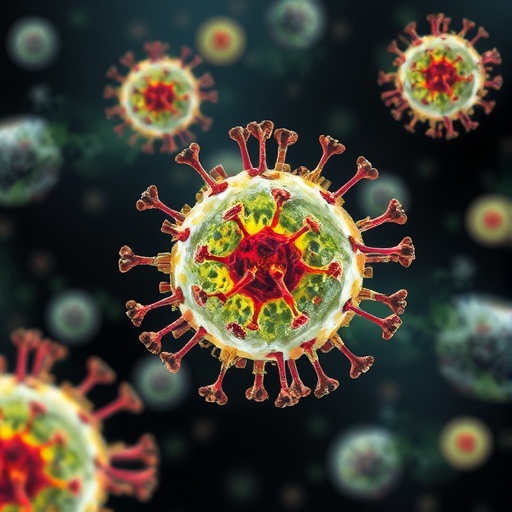In a groundbreaking study published in Nature Microbiology, researchers have unveiled a comprehensive multi-proteomic landscape of the varicella-zoster virus (VZV) interplay with its human host, illuminating previously obscure molecular mechanisms that underlie susceptibility to severe viral infection. This extensive profiling effort not only dissects the complex network of virus-host protein interactions but also clarifies how these interactions influence the host’s cellular environment and immune responses, providing critical insights with implications for future therapeutic strategies.
Varicella-zoster virus, the causative agent of chickenpox and shingles, is a neurotropic alpha-herpesvirus known for its capacity to establish lifelong latency and cause chronic afflictions upon reactivation. Despite the clinical significance of VZV, the molecular intricacies governing its interface with host cells have remained elusive, largely due to the virus’s complex lifecycle and its subtle modulation of host cellular pathways. The new study leverages state-of-the-art multi-proteomic approaches to decode the dynamic biochemical exchanges at the virus-host interface during active infection.
The investigative team employed comprehensive proteomic analyses encompassing affinity purification coupled to mass spectrometry (AP-MS), tandem mass tag (TMT) multiplexed quantitative proteomics, and phosphoproteomic profiling. This robust combination allowed the researchers to capture a high-resolution snapshot of both stable and transient protein interactions and post-translational modifications as the infection progressed. By focusing not merely on viral proteins but also on the host proteome remodeling events, the study identifies pivotal host factors co-opted or antagonized by VZV.
Many of the identified interactions highlight crucial nodes in the host’s innate immune signaling pathways, including components of the interferon response system, ubiquitin-proteasome machinery, and cell death regulators. Particularly, the modulation of pattern recognition receptors (PRRs) and downstream signaling adaptors appears central to the viral evasion strategies. The virus orchestrates an intricate reprogramming of the host proteostasis network, promoting an environment conducive to viral replication while dampening effective antiviral defenses.
Intriguingly, the multi-layered proteomic data reveal novel host proteins not previously associated with herpesvirus infection, implicating them as potential susceptibility factors. These discoveries pave the way for exploring host-targeted antiviral interventions, which could complement or surpass existing therapies focused solely on viral components susceptible to resistance mutations. The identification of such host factors also offers avenues for personalized medicine approaches by linking genetic predispositions to differential infection outcomes.
The study further elaborates on the temporal dynamics of VZV-host interactions, demonstrating that the virus manipulates distinct host pathways in early versus late stages of its replication cycle. Early infection is characterized by the suppression of antiviral signaling and induction of metabolic remodeling, whereas later stages see enhanced modulation of cytoskeletal elements and vesicular trafficking systems necessary for virion assembly and egress. This sophisticated temporal choreography underscores the complexity of viral pathogenesis and contextualizes the multifaceted impacts of VZV within infected tissues.
In terms of technical innovation, the study’s integration of phosphoproteomics provides unprecedented insights into the phosphorylation-dependent regulation of host and viral proteins during infection. Dynamic phosphorylation events can modulate protein activity, interactions, and localization, thus representing critical switches that viruses exploit. The team’s ability to map these modifications across the infection timeline represents a significant advancement in understanding post-translational signaling in virus-host interactions.
Moreover, bioinformatic analyses and network modeling derived from the proteomic datasets have enabled the construction of a comprehensive interaction atlas. This atlas serves as a valuable resource for the scientific community to further investigate functional modules perturbed by VZV infection. Computational clustering and pathway enrichment analyses revealed enrichment of pathways linked to cellular stress responses, autophagy, and RNA metabolism, highlighting additional layers of host manipulation that warrant deeper inquiry.
The study notably addresses host cell heterogeneity by comparing proteomic profiles across different cell types susceptible to VZV, including neuronal and epithelial cells. The differential interaction landscapes observed suggest cell type–specific susceptibilities and responses, which might explain the virus’s varied pathological manifestations, ranging from skin rashes to severe neurological complications. Understanding these distinctions is crucial for developing tissue-targeted therapeutic modalities.
Beyond identifying host factors, the study investigates specific viral proteins acting as key modulators of infection severity. Some VZV proteins were found to interact with central hubs in immune signaling networks, effectively acting as molecular antagonists to host defenses. These findings provide a more nuanced picture of viral protein functionalities beyond their canonical roles in viral replication and structural assembly.
Given the increasing incidence and severity of VZV reactivation diseases in immunocompromised populations and aging adults, this research offers timely insights with direct clinical relevance. The molecular insights into host susceptibilities can inform risk stratification in vulnerable patient cohorts and inspire the development of predictive biomarkers for severe infection outcomes, potentially guiding prophylactic or early therapeutic interventions.
This comprehensive multi-proteomic study stands as a testament to the power of integrating cutting-edge mass spectrometry with advanced computational analyses to unravel virus-host interplay at an unprecedented depth. By charting the molecular underpinnings of VZV infection severity, the research opens promising avenues for antiviral drug discovery and precision medicine approaches tailored to individual host-virus interaction profiles.
As research continues to evolve in this domain, these findings will undoubtedly serve as a foundational platform for future mechanistic and translational studies. The detailed proteomic atlas and interaction framework generated herein will foster collaborative efforts across virology, immunology, and therapeutic development fields, driving innovations aimed at mitigating the global burden of varicella-zoster virus infections.
Subject of Research: Multi-proteomic analysis of the varicella-zoster virus-host protein interaction network to elucidate host susceptibilities to severe infection.
Article Title: Multi-proteomic profiling of the varicella-zoster virus–host interface reveals host susceptibilities to severe infection.
Article References:
Girault, V., Stukalov, A., Carter-Timofte, M.E. et al. Multi-proteomic profiling of the varicella-zoster virus–host interface reveals host susceptibilities to severe infection. Nat Microbiol (2025). https://doi.org/10.1038/s41564-025-02068-7
Image Credits: AI Generated




